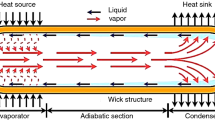Abstract
With the development of economy, the shortage of energy and environmental problems is increasingly prominent. Phase change energy storage technology can effectively solve the energy mismatch in space and time. Phase change cold storage materials are classified into organic materials, inorganic materials and composite materials, which usually have disadvantages such as high supercooling, severe phase separation and poor heat transfer performance. As a new heat transfer structure, pulsating heat pipe has the advantages of simple structure, high efficiency and economy. The physical model and the mathematical model of heat pipe cold storage are established and calculated by using pulsating heat pipe to enhance heat transfer. A movable heat pipe cold storage device was developed and experimental research was carried out. With the decrease of the cold source temperature, the pulsating heat pipe starts faster, liquefies and transfers the cooling capacity more easily, and the cooling time of PCM is shorter. With the increase of heat source temperature, pulsating heat pipe starts faster, evaporates and transfers heat more easily, and the cooling time of phase change material is shorter.






source temperature












Similar content being viewed by others
References
Huang X, Guruprasad A, Jia Y et al (2017) Keywords: Phase change materials, morphological characterization. Application in thermal energy storage, Renewable Energy and Sustainable Energy Review 72:128–145
Wang Y, Liang Dan, Liu Feng et al (2016) Keywords: polyethylene glycol, hydroxyapatite, Thermal storage composite phase change materials, Appl Thermal Eng 113:1475–1482
Geng Ma, Sheng L, Sheng X et al (2017) A binary eutectic mixture of n-butylamide stearate/n-octylamide used as a phase change material for low temperature solar energy heat storage. Applied Thermal Engineering 111:1052–1059
Kahwaji S, Johnson M B, Kheirabadi AC et al (2017) Fatty acids and associated phase change materials reliably store heat at moderate temperatures. J Solar Mater Solar Cells 167:109–120
Carson JK, East AR (2017) New Zealand's Cold Chain Review. Intern J Refrige 185–192
Gracia AD, Cabeza LF (2015) Thermal storage of phase change materials and buildings. Energy Architect 103:414–419
Zhou Z, Zhang Z, Left J et al (2015) Phase change materials for solar energy storage in residential buildings in cold climate. Rev Renew Sustain Energy 48:692–703
Souayfane F, Fardoun F, Biwole PH (2016) Phase change materials (PCM) for building refrigeration: A Rev Energy and Architecture 129:396–431
Zhang Na, Yuan Yuping, Du Yanxia et al (2014) Keywords: Palm stearic acid low eutectic mixture/expanded graphite composites, energy storage, phase change material energy 78:950–956
Meysam F, Mohammad BS (2017) Keywords: Solar still, external heat storage system, phase change material. Heat pipe seawater desalination 409(5):128–135
Jiantang Z, Zhihua R, Chunzhong L, Yanming Li (2016) Experimental study on the coupling of oscillating heat pipes with phase change materials for thermal energy storage and thermal management. Intern J Heat Mass Exchange 8:252–260
Akachi H (1994) Ring capillary tube [P]. Japanese Patent: No. Hei6–97147
Xianhaizhen, Chuanchao W, Yongping Y et al (2013) Keywords: aqueous pentane solution, oscillating flow heat pipe, J Visual Experiment Eng Thermophys 34(7) : 1343–1346
Liangan G (2011) Experimental Study on pulsating heat pipe. Dalian Maritime University, Dalian
Lin Z, Wang S, Shirakashi R et al (2013) Keywords: bottom heating mode, small oscillating heat pipe, CFD, unsteady modeling. Intern J Heat Mass Exchange 57(2) : 642–656
Yuan Dan Qu, Wei MT (2010) (in Chinese) Flow and heat transfer of liquid plugs and nearby air masses in pulsating heat pipes. Intern J heat Mass Exchange 53(7–8):1260–1268
Song Y, Xu Jin (2009) Chaotic behavior of pulsating heat pipes. Intern J Heat Mass Exchange 52(13–14): 2932–2941
Xiangdong L, Sheng Q, Yongping C et al (2016) Keywords: closed loop of pulsating heat pipe, pulsating characteristics of thermo-force liquid two-phase. J Nonlinear Res Eng Thermophys Sc 37(4):825–829
Liang Q, Hao T, Wang K et al (2016) Keywords: ionic liquid, pulsating heat pipe, start-up and operation of engineering thermophysical journal. 37(12) : 2680–2683
Jiansheng W, He Ma (2015) Effect of length ratio of evaporation/condensation on performance of pulsating heat pipe. Chem Industry Prog 34(11):3846–3851
Jichi CAI, Ruixiang W, Rongji X et al (2016) Keywords: SDBS, start of copper water pulsating heat pipe. Chem J Heat Ttrans Perform 57(5): 1852–1857
Wang X, Li Da, Li Yunzhao (2014) Keywords: methanol solution, pulsating heat pipe, heat transfer characteristics, chemical industry and engineering progress. 33(12): 3170–3175
Wilson C, Borgmeyer B, Winholtz RA et al (2011) Keywords: water and acetone, oscillating heat pipe, heat observation and heat transfer. 133(6): 15021–15025
Yang Honghai, SUN Xiao, Groll M (2007-2010) Influence of thermophysical properties of working fluid on operation performance of pulsating heat pipe. J Mechanic 42(2): 155–159. J Eng Thermophys 31(1): 97–99
Patel VM, Gaurav, Mehta HB (2017) Effect of working fluid on the start-up mechanism and thermal performance of closed loop pulsating heat pipe. Appl Thermal Eng 110(1): 1568–1577
Shi Wenxia, PAN Lisheng (2011-2017) Effects of liquid filling ratio and workflow body heat performance on the start-up and heat transfer performance of closed-loop parallel channel oscillating heat pipe. J Phys Chem 27(05): 1097–1098. J Thermal Sci 26(1): 73–81
Lin Z, Wang S, Chen J et al (2011) Keywords: small oscillating heat pipe, effective range application thermal engineering. 31(5): 880–886
Akachi H, Polasek F, Stulc P (1996) Pulsating Heat Pipes.Andrews J Proc 5th Intern Symp Heat Pipes, Melbourne, Australia. 208–217
Acknowledgements
Thanks for the support of the project: National Key Research and Development Plan of China (2018YFD0401300), Shanghai Science and Technology Project (16040501600), Doctoral Innovation Fund of Shanghai Maritime University (2017YCX081).
Author information
Authors and Affiliations
Corresponding author
Rights and permissions
About this article
Cite this article
Xu, X., Zhang, X. & Xiao, Y. Research on influence of high and low temperature heat sources for heat transfer characteristics of pulsating heat pipe cold storage device. Heat Mass Transfer 58, 233–246 (2022). https://doi.org/10.1007/s00231-021-03108-8
Received:
Accepted:
Published:
Issue Date:
DOI: https://doi.org/10.1007/s00231-021-03108-8



